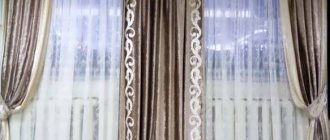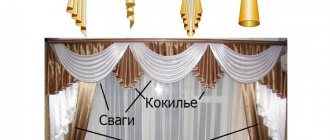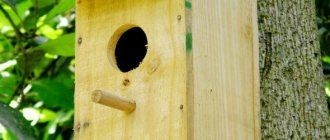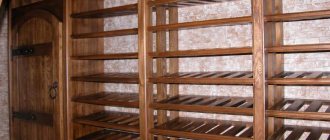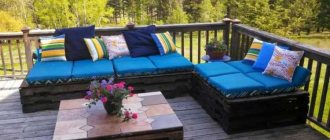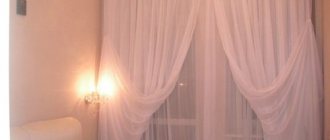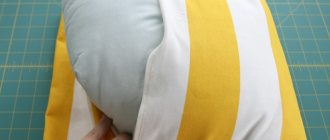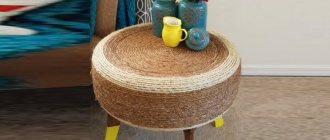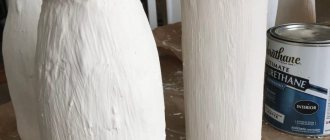What are lambrequins?
The word "lambrequin" has French roots and means "carved decoration." The item itself looks like a heavy drapery placed across the window, at the top of the frame.
Since ancient times, complex and openwork ornaments and lace patterns have been used in interior design to give it a special charm and sophistication.
Supplements usually include:
- fringe;
- brushes;
- ribbon;
- ruffles;
- eyelets;
- waves;
- braid.
Wide range of options for choosing configurations, colors and shapes makes it possible to create hundreds of different design options.
The main use of this element in the interior is aesthetic. The lambrequin covers the cornices and the empty space between the two panels, which completes the design of the window.
Depending on the style and design of the room, you can choose a suitable pattern, or create an original project yourself.
Additional information: Using a lambrequin you can also visually reduce or increase the window opening. It all depends on how high or low it is hung, what shape it has.
Depending on the style and design of the room, you can choose a suitable pattern, or create an original project yourself.
Windows decorated with carved lambrequins look sophisticated. The patterns look especially bright in combination with a simple light-colored fabric. There are many easy options for making your own decorations.
Window decor with openwork elements will add zest to your interior.
Beautiful ideas for decorating windows in the interior
Typically, in wide rooms, models with a variety of decorative elements are used. The more complex the design, the fewer patterns there should be on the material, otherwise you can overload the interior of the apartment.
The bandeau model is the least “whimsical” type of rigid lambrequin. It is suitable for different window openings and doors. When choosing, you need to pay attention to the width.
Interesting ideas for decorating windows in rooms
If there is too little light in the room, then you can purchase transparent material that will ideally transmit daylight.
You might be interested in this: How to choose color and fabric for tulle voile
Note! Classic fabric models are very popular. However, they require special care. For those who don’t have time for this, you can choose openwork and figured models. They are attached to the cornice using self-adhesive tape.
How to sew an openwork lambrequin with your own hands?
If you have the time and energy, you don’t have to go to a special store - you can decorate the house yourself. The main advantage of this type of product is its ease of manufacture and maintenance. Even a beginner can sew openwork lambrequins. The first step is to choose a base - the ideal solution would be a self-adhesive bandeau base.
First, take a bandeau - a rigid base, which is sealed on the front side with curtain fabric.
Attention! The material must be handled very carefully. The smallest inaccuracy can spoil the final result.
For sewing you will need:
- main material;
- lining;
- thermal bandeau;
- cords and fringe;
Decorating ordinary items with fringe completely changes their appearance, turning things into unusually beautiful and stylish accessories.
- thread of the desired color;
- whatman;
- scissors.
Tools and materials.
Next, you need to use step-by-step instructions to complete the job correctly. An important decision is the choice of a sketch for the future decorative element.
On the Internet there are a large number of interesting offers for openwork lambrequins with photos.
The quick manufacturing guide includes several steps.
- We are preparing the pattern. We transfer the selected pattern to whatman paper and cut it out.
- We attach the resulting stencil to a heat-resistant fabric - a bandeau.
- We decorate the resulting product with the main fabric, laying it on top.
- We attach the lining to the wrong side using glue webs.
- We sew a zigzag stitch along the edge, adding cord or fringe.
Step-by-step instruction.
Note! You cannot choose natural fabrics - only synthetics. You might think about felt lambrequins. Also, the material should not be friable, since the edges can “fan” over time.
Machine stitching is an inexpensive and accessible processing option.
Processing the edge of the lambrequin with a zigzag
It is also possible to process it with a laser, if such a possibility exists. The only drawback will be the edges of the thermal bandeau, visible from some viewing angles.
Laser cutting is a non-contact method of processing fabrics, allowing you to achieve high cutting accuracy and an absolutely even cut of the material.
A quick method with high-quality results is burning onto fabric. The question of how to cut a figured lambrequin from an unnecessary curtain is solved in exactly this way.
Product patterns can be of varying degrees of complexity - from simple and laconic lines to ornate carved weaves that create a single fantasy pattern.
Designs for a nursery or bedroom
A simple but very beautiful lambrequin called “Scarf”, complemented by formal curtains, can be placed in a bedroom or nursery.
See how to sew a product step by step:
- Let's determine the dimensions of the product. To prevent the swag or sagging from darkening the room, it should occupy no more than 6th part of the opening.
- Let's outline the height of the lambrequin;
- Fold the fabric in half, from its middle along the upper edge in both directions we mark ½ the length of the cornice, along the lower edge - the height of the sag;
- Connect the top and bottom points on each side, marking the line for sewing on the braid;
- Along the upper edge we will add the height of the folds to the width of the cornice. From the extreme point we draw a line down.
- Add allowances (2 cm each) to the resulting rectangle on the sides.
- We cut the fabric along the marked lines and bend it on all sides.
- Along the upper edge, equal to the length of the cornice and diagonal lines, we sew curtain braid.
Where the tape runs diagonally, we pull it together with the cords. Thus, we got a central swag with folds in a semicircle and coattails on the sides.
Tip: screed areas are decorated with decorative elements such as flowers and butterflies.
How to correctly make flowers for lambrequins?
Floral motifs always remain popular, and flowers can add a special charm to the interior of a room. Even a novice needlewoman can make voluminous fabric flowers with a garland of petals. It doesn’t require a lot of costs or materials.
Possibility of masking poorly chosen cornice and architectural flaws of the window opening.
To make it you need to have:
- interlining;
- thin cardboard;
- base fabric;
- glue stick;
- bias tape;
- decorative tape;
- shiny beads;
- a thread;
- scissors;
- iron.
Necessary materials and tools.
First you need a pattern of petals and leaves - at the initial stage we cut out the parts from cardboard. It is best to outline the resulting parts on non-woven fabric with chalk. In total, you will need 3 large petals (calculating the proportions of the lambrequin) and 5 smaller leaves. After this, we begin the main work.
- Apply glue to the non-woven fabric and apply it to the underside of the fabric.
- Carefully cut out fabric blanks for both sides - a total of 6 and 10.
- First, we run a heated iron along one side. When the product holds tightly, use a glue stick and apply the second part of the fabric.
- Next, you will need to decorate the edges with trim to remove imperfections.
- When each piece is glued and processed, we move on to assembly.
Decorates the curtain composition, acting as an exclusive addition that gives the window design a bright personality.
When collecting a flower, we will try to use our imagination. We connect the three petals with a thread, covering the junction with a bunch of decorative tape. We fasten the leaves with a double-stitched ribbon and add beads on threads. You should get an elegant leafy garland. For splendor, you can omit several ribbons without foliage.
A variety of shapes, designs and colors allows you to choose a bandeau model for any interior.
Important! You should pay attention to the color scheme. The edging of the flower should match the color of the ribbons.
Decorative finishing
Any curtains that have a rigid lambrequin (photo below) look stylish and very original due to the shape of the part. However, additional decoration will also come in handy. You can decorate the edges of the finished product as follows:
- fringe;
- braid;
- cord;
- bugles.
Usually this is done from below. The surface of the part can also be decorated with a sewn pattern from the elements listed above or use other objects, such as:
- bows;
- flowers;
- butterflies and dragonflies;
- beads;
- eyelets;
- sequins.
The choice of decor is determined by the fabric, shape and model of the lambrequin. If it is sewn from several multi-colored parts of a complex shape or the fabric has a contrasting bright pattern, additional decor will not be required.
What are the features of a double openwork lambrequin?
Figured lambrequins can be fixed on top of ordinary ones, which gives the overall picture a special flavor. Regarding the shade, it is better to create a sharp contrast between the background and the patterned decor. If you have a regular fabric decoration, you just need to secure the openwork part on top. You will need to ensure that the pattern for the second layer fits well with the rest of the interior solutions for the windows.
The designs of the products can be simple, with laconic, clear lines, or complex, with ornate carved interweavings of a single fantasy pattern.
You can find a lot of monograms, ornaments and stencils for lambrequins to create your own style. The types of window decorations, often consisting of several parts, are striking in their diversity.
The value of handmade products is undeniable: they are true works of art.
The whole picture usually consists of details such as:
- swag (a sagging piece of fabric with gathers);
- jabot (fabric cascade falling along the edge);
- tie (lancet horizontal folds);
- puffs (lush and puffy patterns);
- mold (central element having an acute angle).
The presented products can be made from a set of the following elements.
Note! You should always combine elements in such a way that bright, eye-catching colors do not outweigh calm tones.
Required skill level
Beginning craftswomen or craftsmen are not recommended to choose models that are complex in cut, for example, consisting not only of swags (loosely hanging semicircles), but also molds and de jabot. It is better to opt for a regular soft lambrequin with a curved shape.
More experienced craftsmen can sew additional decorative elements using special patterns:
Scheme for constructing a mold
Pattern de jabot
Swag turning into de jabot
How to make a lambrequin from cord and wire?
Sleight of hand and numerous tips on the Internet will help you create an unusual window design. You don’t need to spend a lot of time fiddling around making a lambrequin from a cord. Thanks to its minimalistic appearance, it can become part of a double lambrequin without being excessive. A similar product is created using only 3 basic items: furniture cord, thick paper and wire.
Making accessories using this technique began relatively recently.
- You will need to find the desired sketch and put it on paper.
- Then tightly wrap the wire base with a cord of the desired shade.
- Secure the tips with a glue gun and mask them with strong thread.
Just three years ago, one of the curtain factories proposed and began to implement this idea. - Carefully bend the future product, focusing on the contour of the drawing.
- At the points of contact, sew with small pieces of wrapped wire.
Each specialist began to add something of his own to the idea, inventing new versions of the product.
Important! If the wire is stiff and bending is difficult, you will need pliers. In some places it is difficult to do without this tool.
List of required materials
For the master class below on an openwork lambrequin with your own hands, you will need to acquire the following materials and tools:
1. Thick paper.
2. Quilted fabric.
3. Thick adhesive interlining.
4. Face fabric (which matches the curtains).
5. Glue web.
6. Soldering iron (can be replaced with a wood burner or a special fabric burner).
7. Velcro tape.
8. Tailor's meter.
9. Pencil and chalk.
How are windows decorated with openwork lambrequin?
Lambrequins are not new to the interior. The opening is designed along the entire length or in separate parts. Intricate corner decor or a standout patterned dome in the center are popular.
Carved decorations on windows often act as a bright accent in window decoration.
As you can see, decorations vary in shape, location and material. Sometimes their appearance seems catchy and unexpected, because imagination decides everything here. However, the constant in the figured lambrequin remains refined elegance.
Thus, making an openwork lambrequin yourself will not be difficult, provided that the cut is precise and neat.
Arched curtain
- An arched curtain is easy to sew and looks fresh and original.
- Take a piece of fabric, the height of which is equal to the length of the curtain + allowances, and the width is equal to the length of the cornice + allowance for gathering: (can be 2 or 3 lengths of the cornice).
- Next, fold the canvas in half lengthwise, cut out an arch whose width is equal to a third of the width of the window.
- You can sew ruffles and braid to the sections, and sew curtain tape on top.
- Then you need to tighten the canvas to the desired size.
- The top of the curtain can be decorated with an organza chill mold.
Dear friends, knowing how to sew curtains with a lambrequin will help you make your interior something that no one else will have. Creative success!
